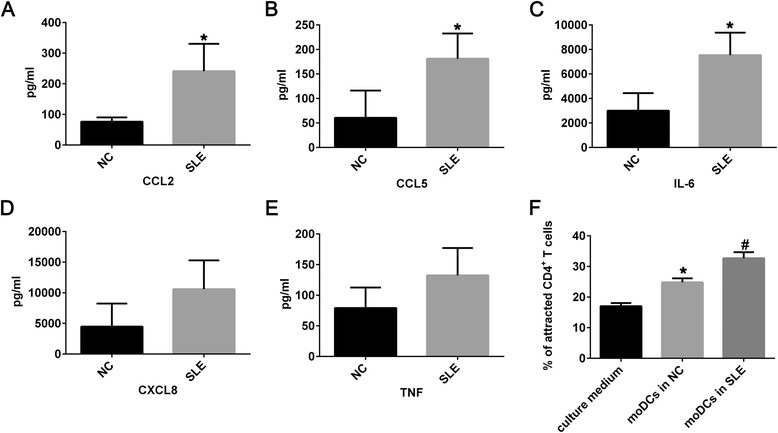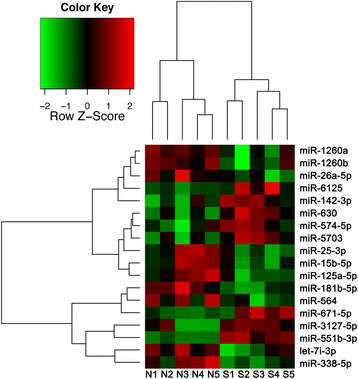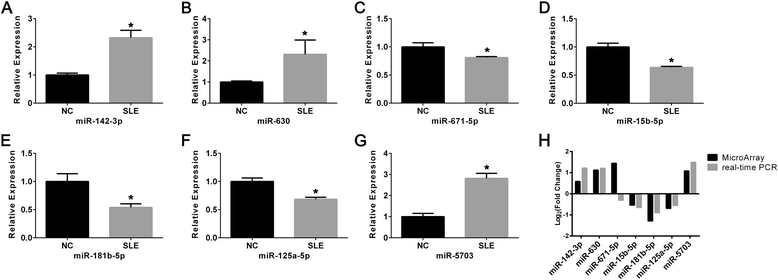Elevated expression of miR-142-3p is related to the pro-inflammatory function of monocyte-derived dendritic cells in SLE
- PMID: 27852285
- PMCID: PMC5112667
- DOI: 10.1186/s13075-016-1158-z
Elevated expression of miR-142-3p is related to the pro-inflammatory function of monocyte-derived dendritic cells in SLE
Abstract
Background: Recent studies have shown that alterations in the function of dendritic cells (DCs) are involved in the pathogenesis of systemic lupus erythematosus (SLE). However, the mechanism of the alteration remains unclear.
Methods: We cultured monocyte-derived DCs (moDCs) in vitro and examined the cytokines and chemokines in the supernatants of moDCs in negative controls (NC) and SLE patients in active phase. We then profiled microRNAs (miRNAs) of LPS-stimulated moDCs in SLE patients and used real-time PCR to verify the differentially expressed miRNAs. A lentiviral construct was used to overexpress the level of miR-142-3p in moDCs of NC. We examined the cytokines and chemokines in the supernatants of moDCs overexpressing miR-142-3p and used Transwell test, flow cytometric analysis and cell proliferation to observe the impact on CD4+ T cells in moDC-CD4+T cell co-culture.
Results: moDCs in patients with SLE secreted increased level of IL-6, CCL2 and CCL5, with attraction of more CD4+ T cells compared with NC. We found 18 differentially expressed microRNAs in moDCs of SLE patients by microarray, and target gene prediction showed some target genes of differentially expressed miRNAs were involved in cytokine regulation. miR-142-3p was verified among the highly expressed miRNAs in the SLE group and overexpressing miR-142-3p in moDCs of the NC group caused an increase of SLE-related cytokines, such as CCL2, CCL5, CXCL8, IL-6 and TNF-α. Moreover, moDCs overexpressed with miR-142-3p resulted in attraction of an increased number of CD4+ T cells and in suppression of the proportion of Tregs in DC-CD4+T cell co-culture whereas the proliferation of CD4+T cells was not altered.
Conclusions: The results demonstrated a role for miR-142-3p in regulating the pro-inflammatory function of moDCs in the pathogenesis of SLE. These findings suggested that miR-142-3p could serve as a novel therapeutic target for the treatment of SLE.
Keywords: MicroRNA; Monocyte-derived DCs; SLE.
Figures






Similar articles
-
Decreased microRNA-142-3p/5p expression causes CD4+ T cell activation and B cell hyperstimulation in systemic lupus erythematosus.Arthritis Rheum. 2012 Sep;64(9):2953-63. doi: 10.1002/art.34505. Arthritis Rheum. 2012. PMID: 22549634
-
LncRNA NEAT1 promotes IL-6 secretion in monocyte-derived dendritic cells via sponging miR-365a-3p in systemic lupus erythematosus.Epigenetics. 2023 Dec;18(1):2226492. doi: 10.1080/15592294.2023.2226492. Epigenetics. 2023. PMID: 37343193 Free PMC article.
-
IL-4 blocks TH1-polarizing/inflammatory cytokine gene expression during monocyte-derived dendritic cell differentiation through histone hypoacetylation.J Allergy Clin Immunol. 2013 Dec;132(6):1409-19. doi: 10.1016/j.jaci.2013.08.039. Epub 2013 Oct 17. J Allergy Clin Immunol. 2013. PMID: 24139608
-
The development and function of dendritic cell populations and their regulation by miRNAs.Protein Cell. 2017 Jul;8(7):501-513. doi: 10.1007/s13238-017-0398-2. Epub 2017 Mar 31. Protein Cell. 2017. PMID: 28364278 Free PMC article. Review.
-
Regulation of B-cell function by miRNAs impacting Systemic lupus erythematosus progression.Gene. 2025 Jan 15;933:149011. doi: 10.1016/j.gene.2024.149011. Epub 2024 Oct 18. Gene. 2025. PMID: 39427831 Review.
Cited by
-
Presymptomatic change in microRNAs modulates Tau pathology.Sci Rep. 2018 Jun 18;8(1):9251. doi: 10.1038/s41598-018-27527-6. Sci Rep. 2018. PMID: 29915328 Free PMC article.
-
MicroRNA-30e-5p has an Integrated Role in the Regulation of the Innate Immune Response during Virus Infection and Systemic Lupus Erythematosus.iScience. 2020 Jul 24;23(7):101322. doi: 10.1016/j.isci.2020.101322. Epub 2020 Jul 1. iScience. 2020. PMID: 32688283 Free PMC article.
-
MicroRNAs in Autoimmunity and Hematological Malignancies.Int J Mol Sci. 2018 Oct 12;19(10):3139. doi: 10.3390/ijms19103139. Int J Mol Sci. 2018. PMID: 30322050 Free PMC article. Review.
-
Exosomal-miRNas expression and growth factors released by mononuclear cells of CLAD patients in response to extracorporeal photopheresis.J Transl Med. 2024 Mar 14;22(1):276. doi: 10.1186/s12967-024-05045-6. J Transl Med. 2024. PMID: 38486224 Free PMC article.
-
Long Noncoding RNA and Circular RNA Expression Profiles of Monocyte-Derived Dendritic Cells in Autoimmune Hepatitis.Front Pharmacol. 2021 Dec 6;12:792138. doi: 10.3389/fphar.2021.792138. eCollection 2021. Front Pharmacol. 2021. PMID: 34938195 Free PMC article.
References
Publication types
MeSH terms
Substances
LinkOut - more resources
Full Text Sources
Other Literature Sources
Medical
Molecular Biology Databases
Research Materials

